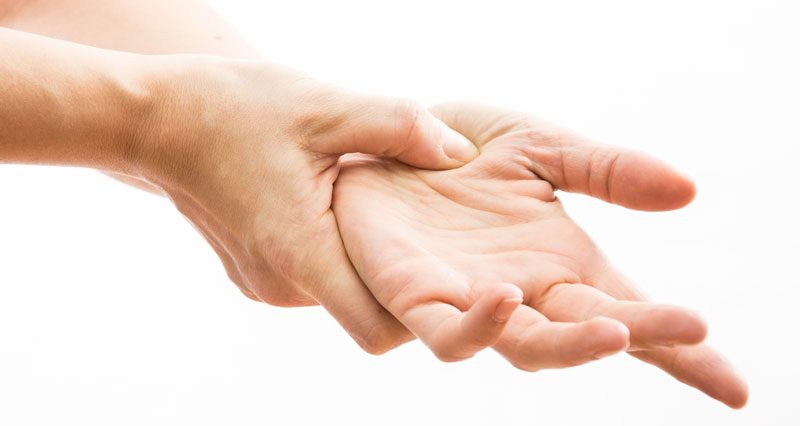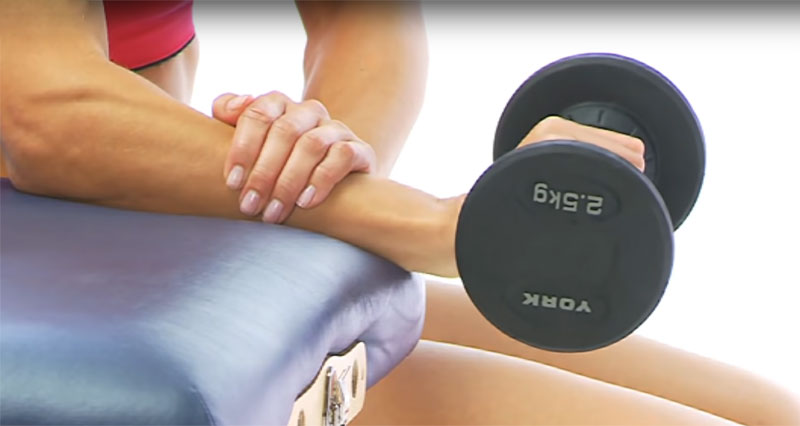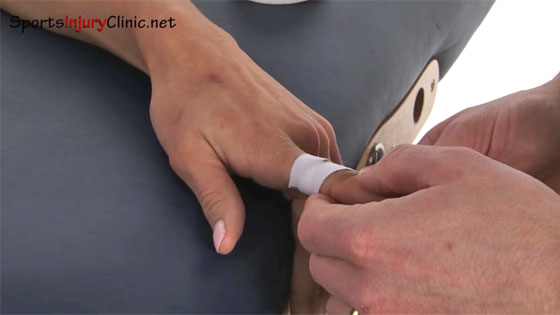Injuries to the hand and fingers are common in sports and must be taken seriously. Here we explain sudden onset (acute) injuries as well as chronic (overuse) hand and finger injuries.
Sudden onset sprains, strains & fractures
Sudden onset injuries are known as acute injuries and are usually caused by direct trauma. They include ligament sprains, tendon strains, and fractures. Acute injuries can become chronic if they are not treated properly.
Sprained finger
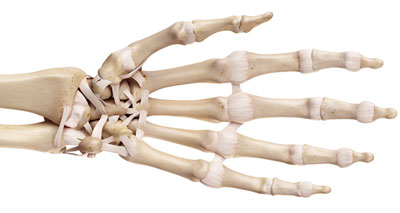
A finger sprain is a tear or stretching of any of the ligaments which connect the finger bones. It occurs when the finger is bent in some way.
Symptoms include:
- Sudden pain
- Swelling
- Tenderness which presses over the injured ligament
- Difficulty moving your finger
More on Sprained finger
Mallet finger
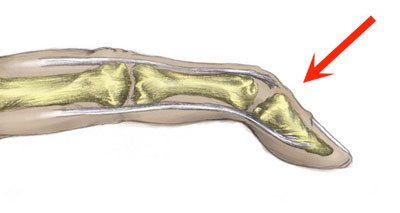
Mallet finger is a condition where you will be unable to extend or straighten the end joint of a finger without assistance.
It can vary from a mild stretching of the tendon to the tendon being pulled away from the bone.
More on Mallet finger
Thumb sprain
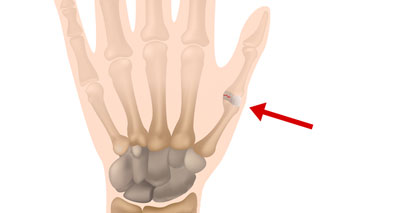
A sprained thumb occurs when the thumb is bent out of its normal range of movement, usually backwards. It can happen in sports like skiing, rugby, and basketball and causes pain and swelling.
The ligaments supporting the joint at the bottom of the thumb get damaged, and this can be helped by taping, icing, and compression.
More on Thumb sprain
Finger fracture
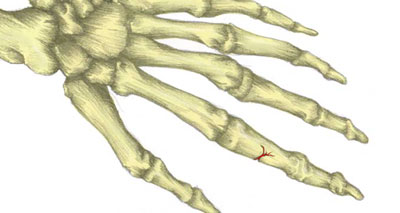
A broken finger is a break or fracture in any one of the 3 small phalange bones which make up each finger. Finger fractures are usually caused by some kind of impact or collision.
Symptoms include:
- You will feel immediate pain with swelling and bruising, which will appear quite quickly.
- It will be painful to try and move your finger, which may appear deformed.
- If there is any nerve damage, the finger may be numb or feel tingly.
More on Finger fracture
Dislocated finger
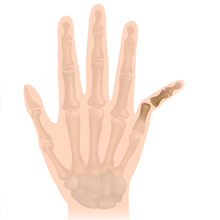
A dislocated finger occurs when two of the finger bones forming joints become displaced, injuring the ligaments and other soft tissue in the process.
Symptoms include:
- Immediate pain with an obvious deformity of the finger
- The patient will have great difficulty trying to move the finger
- It is likely to swell up quickly and bruising may appear later
- If there is any nerve damage then the dislocated finger may feel numb or tingly
- Damage to blood vessels could result in the skin feeling cold and appearing pale
More on Dislocated finger
Jersey finger
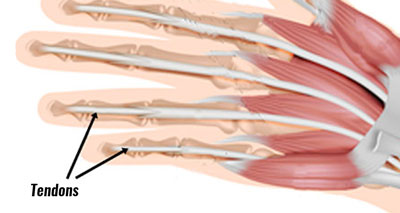
Jersey finger is a tear of one of the flexor tendons in a finger.
Symptoms include:
- Pain in the fingertips.
- Inability to bend your finger normally.
- Tenderness on the pad of the finger will be present.
- Swelling and bruising, which may develop later.
More on Jersey finger
Volar plate injury
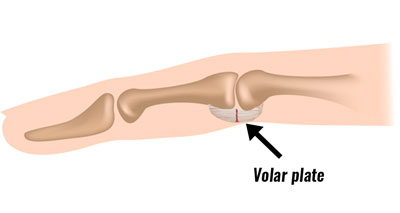
The volar plate is a very thick ligament which joins two bones in the finger.
A volar plate injury occurs when the finger is bent too far back the wrong way, spraining or tearing the ligament. In some cases, this can also involve a fracture.
More on Volar plate injury
Bruised hand
Also known as a hand contusion, occurs due to a direct trauma of the hand. Impacts and crush injuries are the most common causes. This hand injury usually results in bleeding and subsequent bruising and will be painful to touch. Rest and ice are two of the main ways to help this injury.
Gradual onset & chronic hand and finger injuries
Chronic injuries develop over time, usually through overuse. A chronic hand or finger injury can flare up like an acute injury if it is not rested and treated correctly.
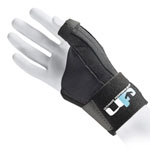
Thumb Supports
Trigger finger/thumb
Triggering is a form of tenosynovitis which results in the finger becoming bent in towards the palm of the hand. This can also occur in the thumb known as the trigger thumb.
There is no specific cause but a variety of factors are detailed below which can make the condition more likely, including gaming and texting! The treatment depends on the severity of the condition and can range from rest to surgery.
More on Trigger finger/thumb
Black fingernail
A black fingernail is known as a subungual hematoma. It is caused by a build-up of blood under the nail, usually as a result of an impact or trauma to the finger. This usually results from an impact or trauma to the finger which can cause considerable pain.
More on Black fingernail
Bowler’s thumb
Bowler’s thumb is an overuse injury resulting from compression or repeated friction on the inside of the thumb. This causes pressure on the Ulnar nerve, resulting in symptoms of numbness and tingling at the end of the thumb.
More on Bowler’s thumb
Boutonniere deformity
Boutonniere deformity or ‘buttonhole’ deformity is an injury to a tendon in one of the fingers which causes the finger to appear deformed.
This usually occurs after an impact on a bent finger. Symptoms include pain at the time of injury with tenderness on top of the middle finger bone which is likely to be swollen.
More on Boutonniere deformity
Cellulitis (finger felon)
Cellulitis is a bacterial infection of the superficial and deep layers of the skin. In the fingertip, this is known as a felon. It is often caused by a small injury to the end of the finger which can make it painful and swell up.
Symptoms include throbbing pain at the end of the finger.
More on Finger felon
Handlebar palsy
Handlebar palsy is a name given to a common condition suffered by cyclists. Symptoms include numbness, tingling, and weakness over the outside of the hand. It is caused by compression of the ulnar nerve at the wrist.
More on Handlebar palsy
Dupuytren’s contracture
Dupuytren’s contracture is a condition which affects the hand and fingers, causing the fingers to bend in towards the palm of the hand. Tissue in the hand contracts and becomes shorter, although this does not normally cause pain. Many cases do not require treatment, although if the condition is severe, there are options you can take.
More on Dupuytren’s contracture
